Levett-Jones Clinical Reasoning Cycle for Nursing Care Prioritization: A Case Study of Amalie
VerifiedAdded on 2023/06/13
|7
|2623
|101
AI Summary
This paper discusses the implementation of Levett-Jones clinical reasoning cycle and Miller’s Functional Consequences Theory in identifying nursing care prioritization for Amalie, an 89-year-old woman with rheumatoid arthritis, osteoarthritis, macular degeneration, and hypothyroidism. The paper sets goals for pain, impaired physical mobility, and impaired vision, and provides actions for assessment and intervention. The outcomes show improvement in pain severity, mood, coping ability, and activities of daily living, and reduction in fall frequency.
Contribute Materials
Your contribution can guide someone’s learning journey. Share your
documents today.
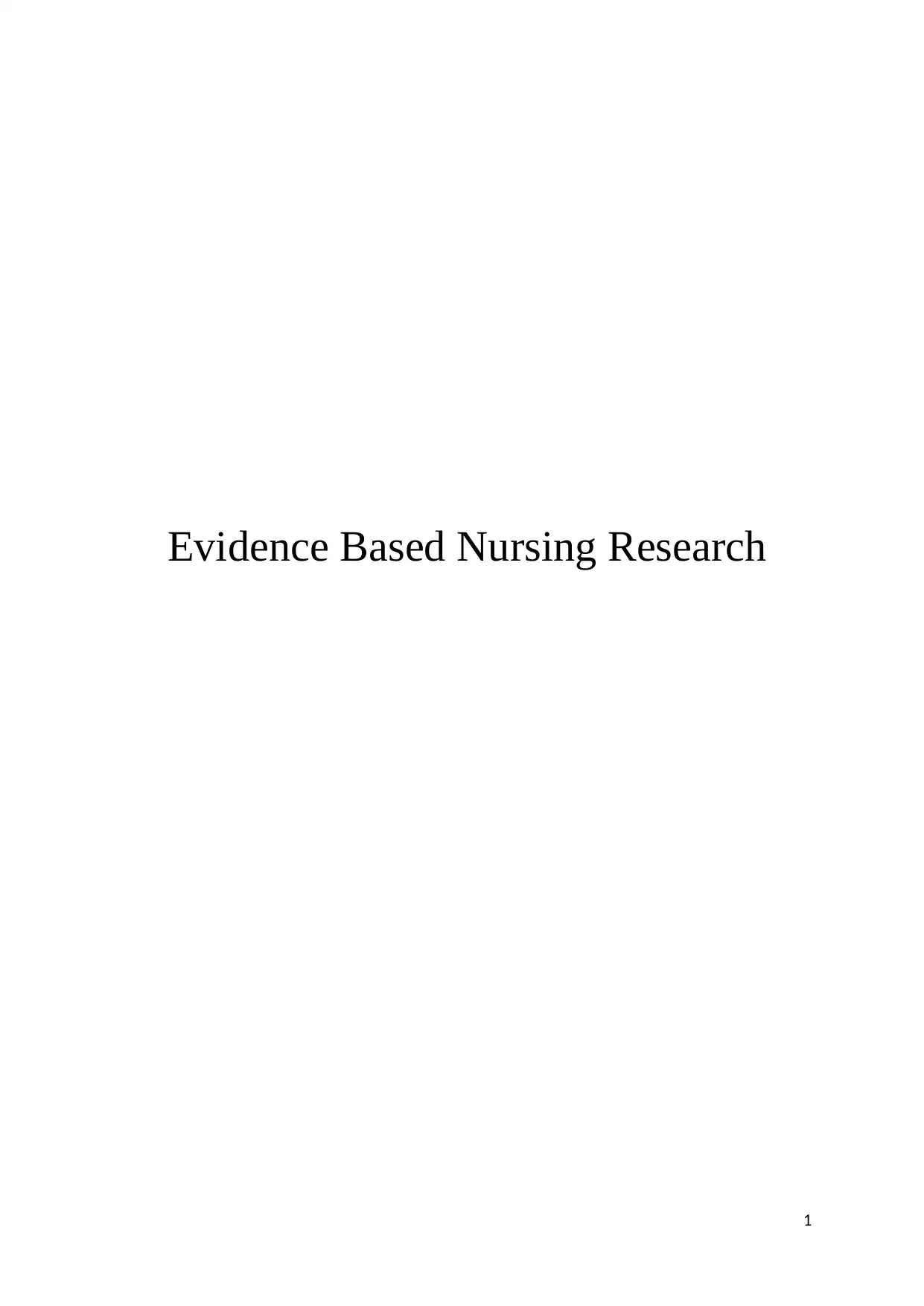
Evidence Based Nursing Research
1
1
Secure Best Marks with AI Grader
Need help grading? Try our AI Grader for instant feedback on your assignments.
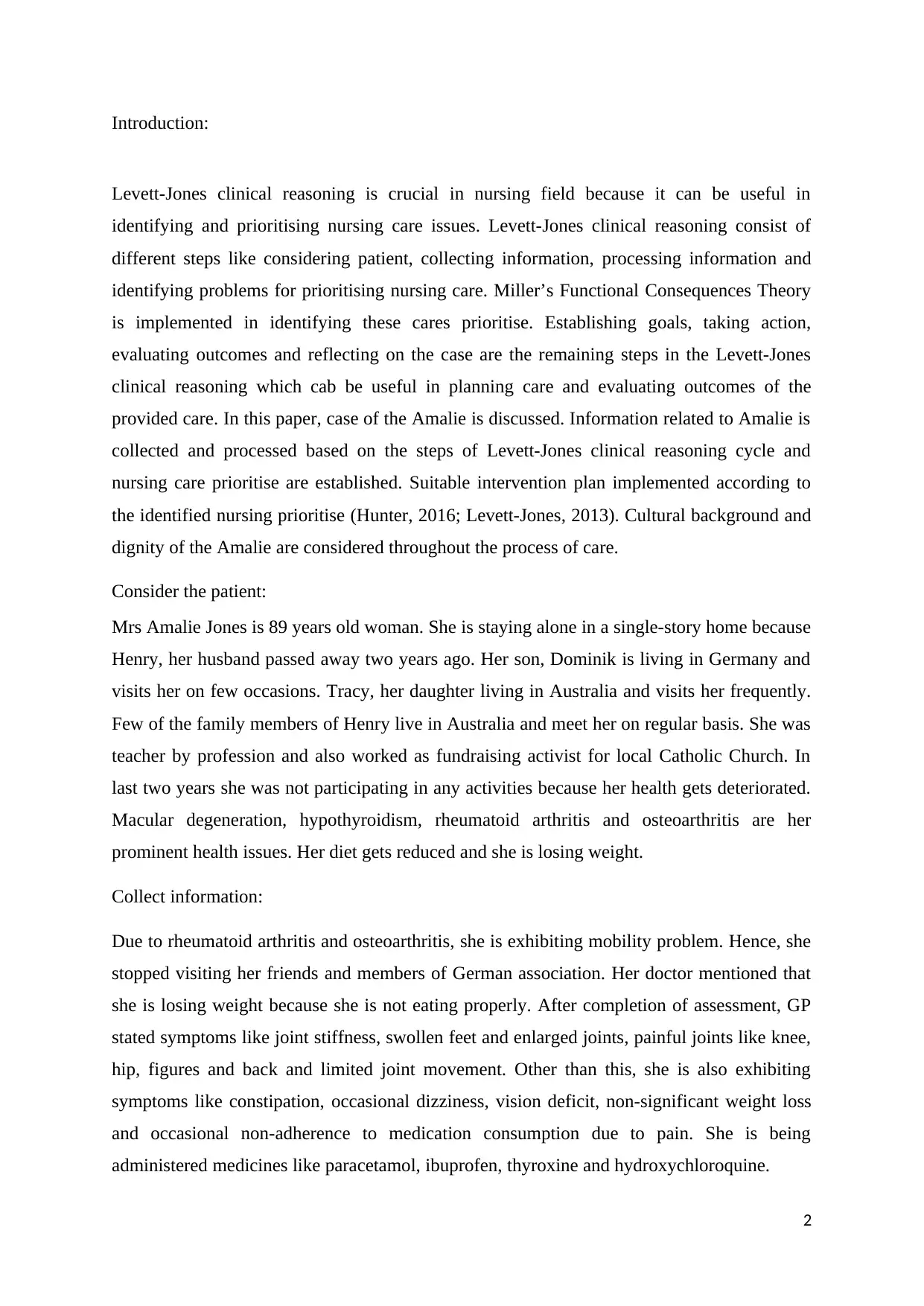
Introduction:
Levett-Jones clinical reasoning is crucial in nursing field because it can be useful in
identifying and prioritising nursing care issues. Levett-Jones clinical reasoning consist of
different steps like considering patient, collecting information, processing information and
identifying problems for prioritising nursing care. Miller’s Functional Consequences Theory
is implemented in identifying these cares prioritise. Establishing goals, taking action,
evaluating outcomes and reflecting on the case are the remaining steps in the Levett-Jones
clinical reasoning which cab be useful in planning care and evaluating outcomes of the
provided care. In this paper, case of the Amalie is discussed. Information related to Amalie is
collected and processed based on the steps of Levett-Jones clinical reasoning cycle and
nursing care prioritise are established. Suitable intervention plan implemented according to
the identified nursing prioritise (Hunter, 2016; Levett-Jones, 2013). Cultural background and
dignity of the Amalie are considered throughout the process of care.
Consider the patient:
Mrs Amalie Jones is 89 years old woman. She is staying alone in a single-story home because
Henry, her husband passed away two years ago. Her son, Dominik is living in Germany and
visits her on few occasions. Tracy, her daughter living in Australia and visits her frequently.
Few of the family members of Henry live in Australia and meet her on regular basis. She was
teacher by profession and also worked as fundraising activist for local Catholic Church. In
last two years she was not participating in any activities because her health gets deteriorated.
Macular degeneration, hypothyroidism, rheumatoid arthritis and osteoarthritis are her
prominent health issues. Her diet gets reduced and she is losing weight.
Collect information:
Due to rheumatoid arthritis and osteoarthritis, she is exhibiting mobility problem. Hence, she
stopped visiting her friends and members of German association. Her doctor mentioned that
she is losing weight because she is not eating properly. After completion of assessment, GP
stated symptoms like joint stiffness, swollen feet and enlarged joints, painful joints like knee,
hip, figures and back and limited joint movement. Other than this, she is also exhibiting
symptoms like constipation, occasional dizziness, vision deficit, non-significant weight loss
and occasional non-adherence to medication consumption due to pain. She is being
administered medicines like paracetamol, ibuprofen, thyroxine and hydroxychloroquine.
2
Levett-Jones clinical reasoning is crucial in nursing field because it can be useful in
identifying and prioritising nursing care issues. Levett-Jones clinical reasoning consist of
different steps like considering patient, collecting information, processing information and
identifying problems for prioritising nursing care. Miller’s Functional Consequences Theory
is implemented in identifying these cares prioritise. Establishing goals, taking action,
evaluating outcomes and reflecting on the case are the remaining steps in the Levett-Jones
clinical reasoning which cab be useful in planning care and evaluating outcomes of the
provided care. In this paper, case of the Amalie is discussed. Information related to Amalie is
collected and processed based on the steps of Levett-Jones clinical reasoning cycle and
nursing care prioritise are established. Suitable intervention plan implemented according to
the identified nursing prioritise (Hunter, 2016; Levett-Jones, 2013). Cultural background and
dignity of the Amalie are considered throughout the process of care.
Consider the patient:
Mrs Amalie Jones is 89 years old woman. She is staying alone in a single-story home because
Henry, her husband passed away two years ago. Her son, Dominik is living in Germany and
visits her on few occasions. Tracy, her daughter living in Australia and visits her frequently.
Few of the family members of Henry live in Australia and meet her on regular basis. She was
teacher by profession and also worked as fundraising activist for local Catholic Church. In
last two years she was not participating in any activities because her health gets deteriorated.
Macular degeneration, hypothyroidism, rheumatoid arthritis and osteoarthritis are her
prominent health issues. Her diet gets reduced and she is losing weight.
Collect information:
Due to rheumatoid arthritis and osteoarthritis, she is exhibiting mobility problem. Hence, she
stopped visiting her friends and members of German association. Her doctor mentioned that
she is losing weight because she is not eating properly. After completion of assessment, GP
stated symptoms like joint stiffness, swollen feet and enlarged joints, painful joints like knee,
hip, figures and back and limited joint movement. Other than this, she is also exhibiting
symptoms like constipation, occasional dizziness, vision deficit, non-significant weight loss
and occasional non-adherence to medication consumption due to pain. She is being
administered medicines like paracetamol, ibuprofen, thyroxine and hydroxychloroquine.
2
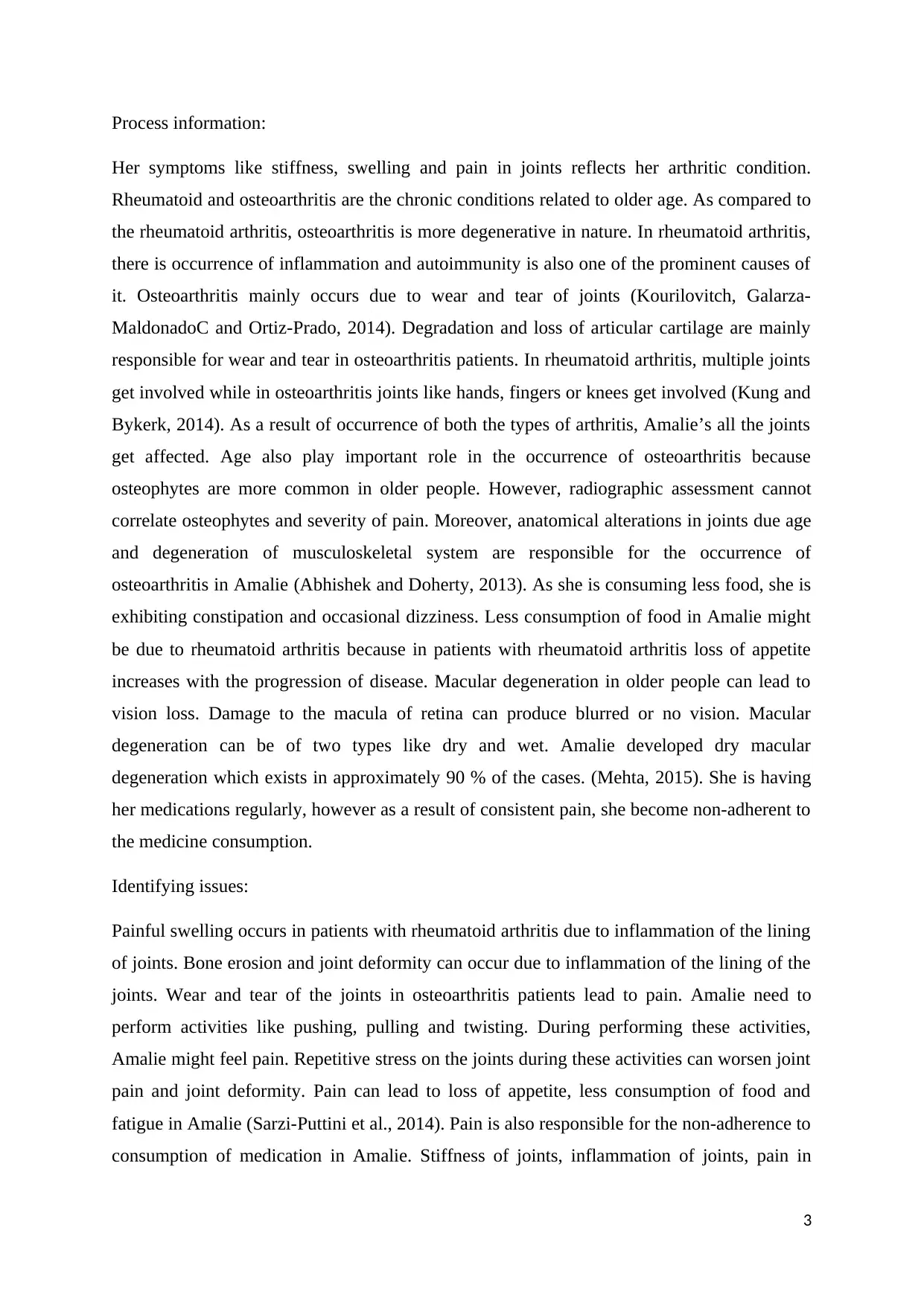
Process information:
Her symptoms like stiffness, swelling and pain in joints reflects her arthritic condition.
Rheumatoid and osteoarthritis are the chronic conditions related to older age. As compared to
the rheumatoid arthritis, osteoarthritis is more degenerative in nature. In rheumatoid arthritis,
there is occurrence of inflammation and autoimmunity is also one of the prominent causes of
it. Osteoarthritis mainly occurs due to wear and tear of joints (Kourilovitch, Galarza-
MaldonadoC and Ortiz-Prado, 2014). Degradation and loss of articular cartilage are mainly
responsible for wear and tear in osteoarthritis patients. In rheumatoid arthritis, multiple joints
get involved while in osteoarthritis joints like hands, fingers or knees get involved (Kung and
Bykerk, 2014). As a result of occurrence of both the types of arthritis, Amalie’s all the joints
get affected. Age also play important role in the occurrence of osteoarthritis because
osteophytes are more common in older people. However, radiographic assessment cannot
correlate osteophytes and severity of pain. Moreover, anatomical alterations in joints due age
and degeneration of musculoskeletal system are responsible for the occurrence of
osteoarthritis in Amalie (Abhishek and Doherty, 2013). As she is consuming less food, she is
exhibiting constipation and occasional dizziness. Less consumption of food in Amalie might
be due to rheumatoid arthritis because in patients with rheumatoid arthritis loss of appetite
increases with the progression of disease. Macular degeneration in older people can lead to
vision loss. Damage to the macula of retina can produce blurred or no vision. Macular
degeneration can be of two types like dry and wet. Amalie developed dry macular
degeneration which exists in approximately 90 % of the cases. (Mehta, 2015). She is having
her medications regularly, however as a result of consistent pain, she become non-adherent to
the medicine consumption.
Identifying issues:
Painful swelling occurs in patients with rheumatoid arthritis due to inflammation of the lining
of joints. Bone erosion and joint deformity can occur due to inflammation of the lining of the
joints. Wear and tear of the joints in osteoarthritis patients lead to pain. Amalie need to
perform activities like pushing, pulling and twisting. During performing these activities,
Amalie might feel pain. Repetitive stress on the joints during these activities can worsen joint
pain and joint deformity. Pain can lead to loss of appetite, less consumption of food and
fatigue in Amalie (Sarzi-Puttini et al., 2014). Pain is also responsible for the non-adherence to
consumption of medication in Amalie. Stiffness of joints, inflammation of joints, pain in
3
Her symptoms like stiffness, swelling and pain in joints reflects her arthritic condition.
Rheumatoid and osteoarthritis are the chronic conditions related to older age. As compared to
the rheumatoid arthritis, osteoarthritis is more degenerative in nature. In rheumatoid arthritis,
there is occurrence of inflammation and autoimmunity is also one of the prominent causes of
it. Osteoarthritis mainly occurs due to wear and tear of joints (Kourilovitch, Galarza-
MaldonadoC and Ortiz-Prado, 2014). Degradation and loss of articular cartilage are mainly
responsible for wear and tear in osteoarthritis patients. In rheumatoid arthritis, multiple joints
get involved while in osteoarthritis joints like hands, fingers or knees get involved (Kung and
Bykerk, 2014). As a result of occurrence of both the types of arthritis, Amalie’s all the joints
get affected. Age also play important role in the occurrence of osteoarthritis because
osteophytes are more common in older people. However, radiographic assessment cannot
correlate osteophytes and severity of pain. Moreover, anatomical alterations in joints due age
and degeneration of musculoskeletal system are responsible for the occurrence of
osteoarthritis in Amalie (Abhishek and Doherty, 2013). As she is consuming less food, she is
exhibiting constipation and occasional dizziness. Less consumption of food in Amalie might
be due to rheumatoid arthritis because in patients with rheumatoid arthritis loss of appetite
increases with the progression of disease. Macular degeneration in older people can lead to
vision loss. Damage to the macula of retina can produce blurred or no vision. Macular
degeneration can be of two types like dry and wet. Amalie developed dry macular
degeneration which exists in approximately 90 % of the cases. (Mehta, 2015). She is having
her medications regularly, however as a result of consistent pain, she become non-adherent to
the medicine consumption.
Identifying issues:
Painful swelling occurs in patients with rheumatoid arthritis due to inflammation of the lining
of joints. Bone erosion and joint deformity can occur due to inflammation of the lining of the
joints. Wear and tear of the joints in osteoarthritis patients lead to pain. Amalie need to
perform activities like pushing, pulling and twisting. During performing these activities,
Amalie might feel pain. Repetitive stress on the joints during these activities can worsen joint
pain and joint deformity. Pain can lead to loss of appetite, less consumption of food and
fatigue in Amalie (Sarzi-Puttini et al., 2014). Pain is also responsible for the non-adherence to
consumption of medication in Amalie. Stiffness of joints, inflammation of joints, pain in
3
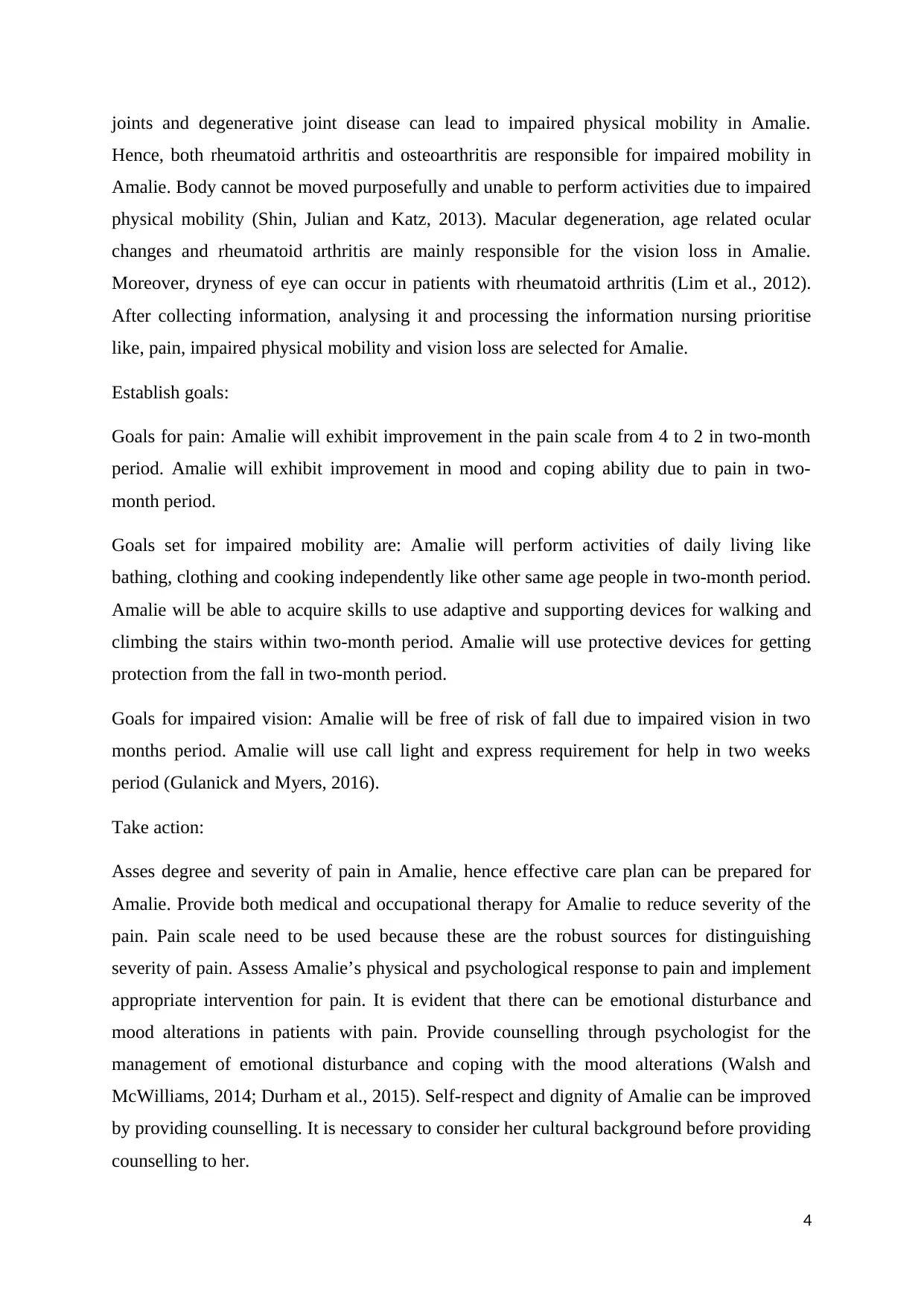
joints and degenerative joint disease can lead to impaired physical mobility in Amalie.
Hence, both rheumatoid arthritis and osteoarthritis are responsible for impaired mobility in
Amalie. Body cannot be moved purposefully and unable to perform activities due to impaired
physical mobility (Shin, Julian and Katz, 2013). Macular degeneration, age related ocular
changes and rheumatoid arthritis are mainly responsible for the vision loss in Amalie.
Moreover, dryness of eye can occur in patients with rheumatoid arthritis (Lim et al., 2012).
After collecting information, analysing it and processing the information nursing prioritise
like, pain, impaired physical mobility and vision loss are selected for Amalie.
Establish goals:
Goals for pain: Amalie will exhibit improvement in the pain scale from 4 to 2 in two-month
period. Amalie will exhibit improvement in mood and coping ability due to pain in two-
month period.
Goals set for impaired mobility are: Amalie will perform activities of daily living like
bathing, clothing and cooking independently like other same age people in two-month period.
Amalie will be able to acquire skills to use adaptive and supporting devices for walking and
climbing the stairs within two-month period. Amalie will use protective devices for getting
protection from the fall in two-month period.
Goals for impaired vision: Amalie will be free of risk of fall due to impaired vision in two
months period. Amalie will use call light and express requirement for help in two weeks
period (Gulanick and Myers, 2016).
Take action:
Asses degree and severity of pain in Amalie, hence effective care plan can be prepared for
Amalie. Provide both medical and occupational therapy for Amalie to reduce severity of the
pain. Pain scale need to be used because these are the robust sources for distinguishing
severity of pain. Assess Amalie’s physical and psychological response to pain and implement
appropriate intervention for pain. It is evident that there can be emotional disturbance and
mood alterations in patients with pain. Provide counselling through psychologist for the
management of emotional disturbance and coping with the mood alterations (Walsh and
McWilliams, 2014; Durham et al., 2015). Self-respect and dignity of Amalie can be improved
by providing counselling. It is necessary to consider her cultural background before providing
counselling to her.
4
Hence, both rheumatoid arthritis and osteoarthritis are responsible for impaired mobility in
Amalie. Body cannot be moved purposefully and unable to perform activities due to impaired
physical mobility (Shin, Julian and Katz, 2013). Macular degeneration, age related ocular
changes and rheumatoid arthritis are mainly responsible for the vision loss in Amalie.
Moreover, dryness of eye can occur in patients with rheumatoid arthritis (Lim et al., 2012).
After collecting information, analysing it and processing the information nursing prioritise
like, pain, impaired physical mobility and vision loss are selected for Amalie.
Establish goals:
Goals for pain: Amalie will exhibit improvement in the pain scale from 4 to 2 in two-month
period. Amalie will exhibit improvement in mood and coping ability due to pain in two-
month period.
Goals set for impaired mobility are: Amalie will perform activities of daily living like
bathing, clothing and cooking independently like other same age people in two-month period.
Amalie will be able to acquire skills to use adaptive and supporting devices for walking and
climbing the stairs within two-month period. Amalie will use protective devices for getting
protection from the fall in two-month period.
Goals for impaired vision: Amalie will be free of risk of fall due to impaired vision in two
months period. Amalie will use call light and express requirement for help in two weeks
period (Gulanick and Myers, 2016).
Take action:
Asses degree and severity of pain in Amalie, hence effective care plan can be prepared for
Amalie. Provide both medical and occupational therapy for Amalie to reduce severity of the
pain. Pain scale need to be used because these are the robust sources for distinguishing
severity of pain. Assess Amalie’s physical and psychological response to pain and implement
appropriate intervention for pain. It is evident that there can be emotional disturbance and
mood alterations in patients with pain. Provide counselling through psychologist for the
management of emotional disturbance and coping with the mood alterations (Walsh and
McWilliams, 2014; Durham et al., 2015). Self-respect and dignity of Amalie can be improved
by providing counselling. It is necessary to consider her cultural background before providing
counselling to her.
4
Secure Best Marks with AI Grader
Need help grading? Try our AI Grader for instant feedback on your assignments.
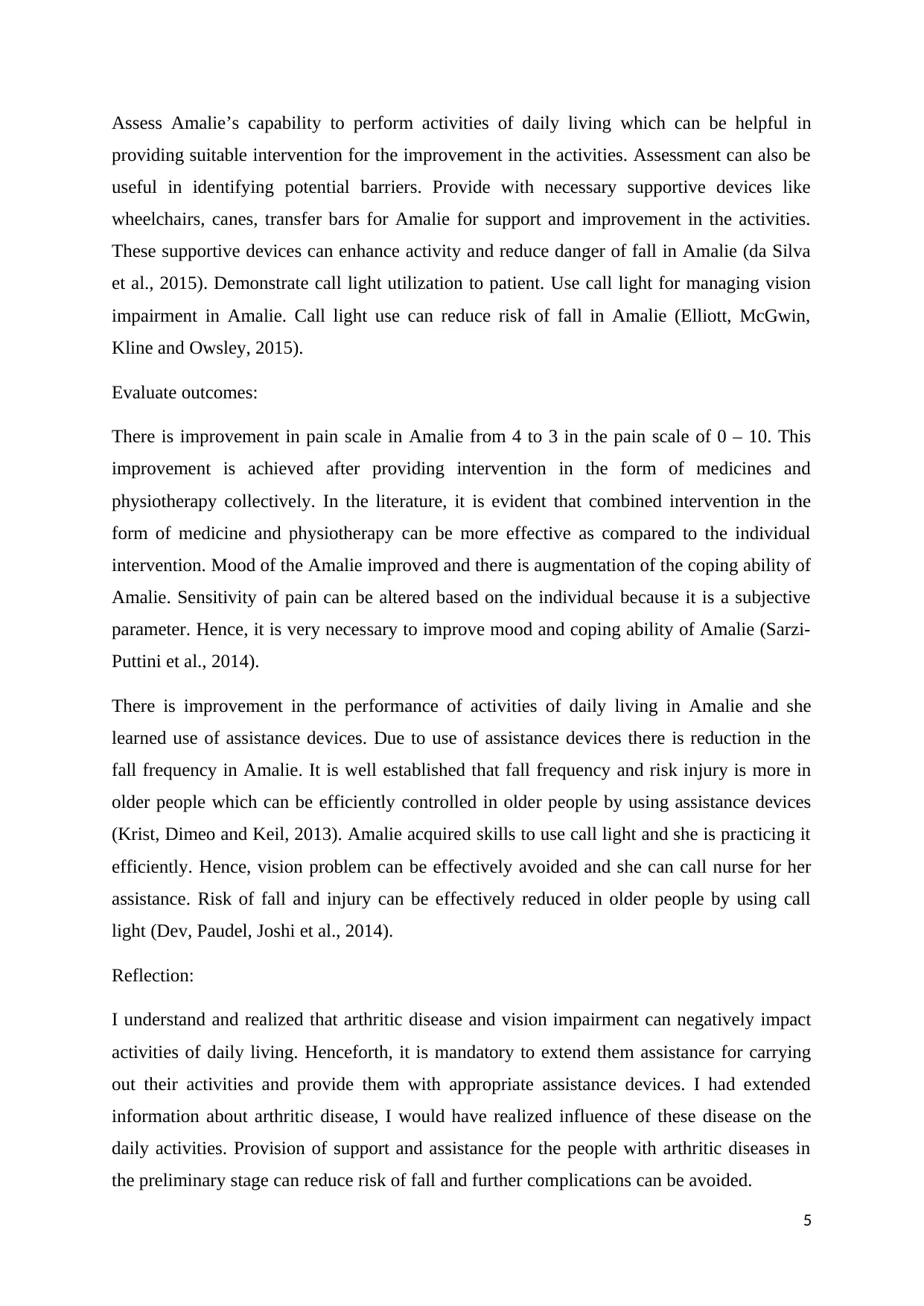
Assess Amalie’s capability to perform activities of daily living which can be helpful in
providing suitable intervention for the improvement in the activities. Assessment can also be
useful in identifying potential barriers. Provide with necessary supportive devices like
wheelchairs, canes, transfer bars for Amalie for support and improvement in the activities.
These supportive devices can enhance activity and reduce danger of fall in Amalie (da Silva
et al., 2015). Demonstrate call light utilization to patient. Use call light for managing vision
impairment in Amalie. Call light use can reduce risk of fall in Amalie (Elliott, McGwin,
Kline and Owsley, 2015).
Evaluate outcomes:
There is improvement in pain scale in Amalie from 4 to 3 in the pain scale of 0 – 10. This
improvement is achieved after providing intervention in the form of medicines and
physiotherapy collectively. In the literature, it is evident that combined intervention in the
form of medicine and physiotherapy can be more effective as compared to the individual
intervention. Mood of the Amalie improved and there is augmentation of the coping ability of
Amalie. Sensitivity of pain can be altered based on the individual because it is a subjective
parameter. Hence, it is very necessary to improve mood and coping ability of Amalie (Sarzi-
Puttini et al., 2014).
There is improvement in the performance of activities of daily living in Amalie and she
learned use of assistance devices. Due to use of assistance devices there is reduction in the
fall frequency in Amalie. It is well established that fall frequency and risk injury is more in
older people which can be efficiently controlled in older people by using assistance devices
(Krist, Dimeo and Keil, 2013). Amalie acquired skills to use call light and she is practicing it
efficiently. Hence, vision problem can be effectively avoided and she can call nurse for her
assistance. Risk of fall and injury can be effectively reduced in older people by using call
light (Dev, Paudel, Joshi et al., 2014).
Reflection:
I understand and realized that arthritic disease and vision impairment can negatively impact
activities of daily living. Henceforth, it is mandatory to extend them assistance for carrying
out their activities and provide them with appropriate assistance devices. I had extended
information about arthritic disease, I would have realized influence of these disease on the
daily activities. Provision of support and assistance for the people with arthritic diseases in
the preliminary stage can reduce risk of fall and further complications can be avoided.
5
providing suitable intervention for the improvement in the activities. Assessment can also be
useful in identifying potential barriers. Provide with necessary supportive devices like
wheelchairs, canes, transfer bars for Amalie for support and improvement in the activities.
These supportive devices can enhance activity and reduce danger of fall in Amalie (da Silva
et al., 2015). Demonstrate call light utilization to patient. Use call light for managing vision
impairment in Amalie. Call light use can reduce risk of fall in Amalie (Elliott, McGwin,
Kline and Owsley, 2015).
Evaluate outcomes:
There is improvement in pain scale in Amalie from 4 to 3 in the pain scale of 0 – 10. This
improvement is achieved after providing intervention in the form of medicines and
physiotherapy collectively. In the literature, it is evident that combined intervention in the
form of medicine and physiotherapy can be more effective as compared to the individual
intervention. Mood of the Amalie improved and there is augmentation of the coping ability of
Amalie. Sensitivity of pain can be altered based on the individual because it is a subjective
parameter. Hence, it is very necessary to improve mood and coping ability of Amalie (Sarzi-
Puttini et al., 2014).
There is improvement in the performance of activities of daily living in Amalie and she
learned use of assistance devices. Due to use of assistance devices there is reduction in the
fall frequency in Amalie. It is well established that fall frequency and risk injury is more in
older people which can be efficiently controlled in older people by using assistance devices
(Krist, Dimeo and Keil, 2013). Amalie acquired skills to use call light and she is practicing it
efficiently. Hence, vision problem can be effectively avoided and she can call nurse for her
assistance. Risk of fall and injury can be effectively reduced in older people by using call
light (Dev, Paudel, Joshi et al., 2014).
Reflection:
I understand and realized that arthritic disease and vision impairment can negatively impact
activities of daily living. Henceforth, it is mandatory to extend them assistance for carrying
out their activities and provide them with appropriate assistance devices. I had extended
information about arthritic disease, I would have realized influence of these disease on the
daily activities. Provision of support and assistance for the people with arthritic diseases in
the preliminary stage can reduce risk of fall and further complications can be avoided.
5
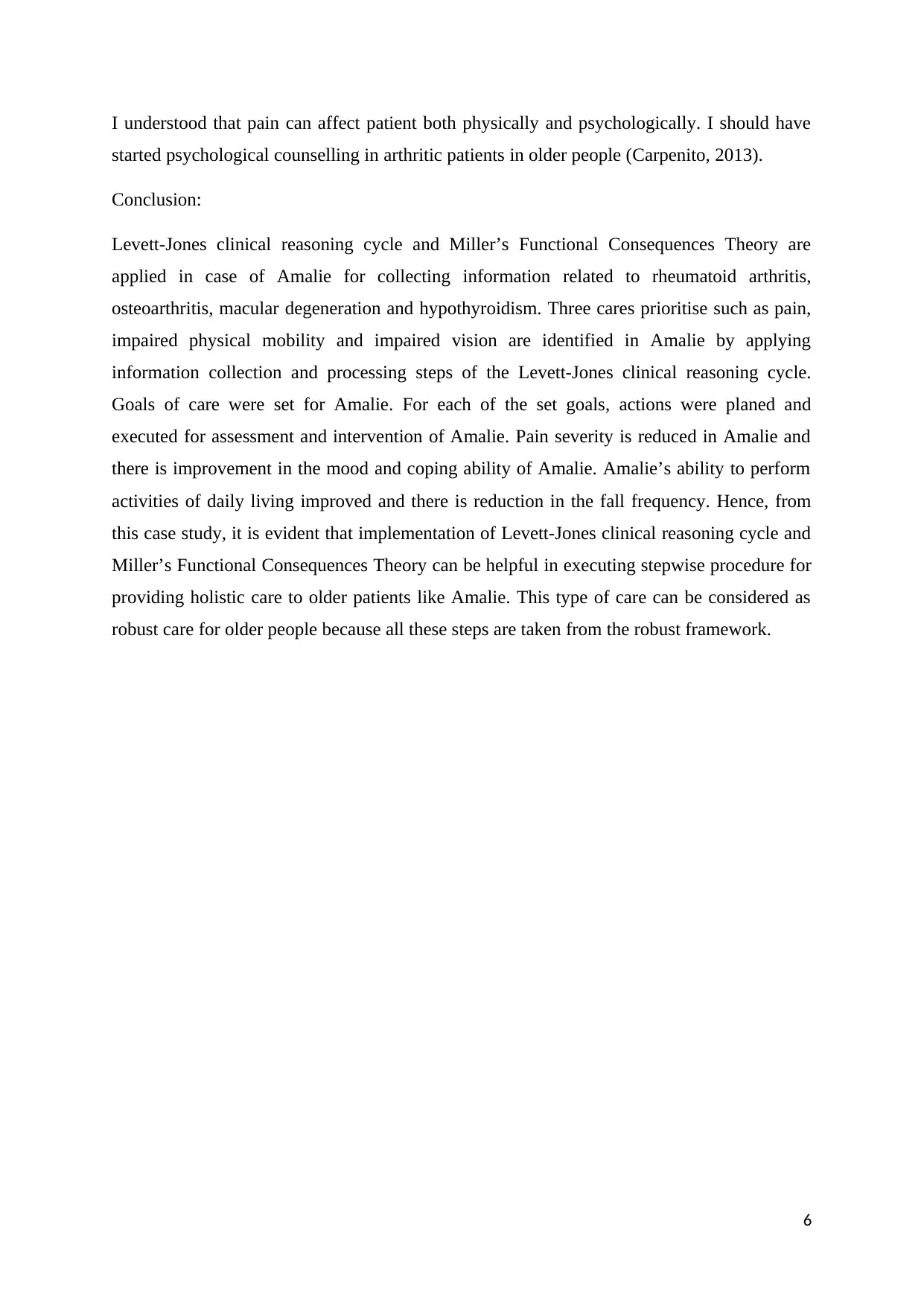
I understood that pain can affect patient both physically and psychologically. I should have
started psychological counselling in arthritic patients in older people (Carpenito, 2013).
Conclusion:
Levett-Jones clinical reasoning cycle and Miller’s Functional Consequences Theory are
applied in case of Amalie for collecting information related to rheumatoid arthritis,
osteoarthritis, macular degeneration and hypothyroidism. Three cares prioritise such as pain,
impaired physical mobility and impaired vision are identified in Amalie by applying
information collection and processing steps of the Levett-Jones clinical reasoning cycle.
Goals of care were set for Amalie. For each of the set goals, actions were planed and
executed for assessment and intervention of Amalie. Pain severity is reduced in Amalie and
there is improvement in the mood and coping ability of Amalie. Amalie’s ability to perform
activities of daily living improved and there is reduction in the fall frequency. Hence, from
this case study, it is evident that implementation of Levett-Jones clinical reasoning cycle and
Miller’s Functional Consequences Theory can be helpful in executing stepwise procedure for
providing holistic care to older patients like Amalie. This type of care can be considered as
robust care for older people because all these steps are taken from the robust framework.
6
started psychological counselling in arthritic patients in older people (Carpenito, 2013).
Conclusion:
Levett-Jones clinical reasoning cycle and Miller’s Functional Consequences Theory are
applied in case of Amalie for collecting information related to rheumatoid arthritis,
osteoarthritis, macular degeneration and hypothyroidism. Three cares prioritise such as pain,
impaired physical mobility and impaired vision are identified in Amalie by applying
information collection and processing steps of the Levett-Jones clinical reasoning cycle.
Goals of care were set for Amalie. For each of the set goals, actions were planed and
executed for assessment and intervention of Amalie. Pain severity is reduced in Amalie and
there is improvement in the mood and coping ability of Amalie. Amalie’s ability to perform
activities of daily living improved and there is reduction in the fall frequency. Hence, from
this case study, it is evident that implementation of Levett-Jones clinical reasoning cycle and
Miller’s Functional Consequences Theory can be helpful in executing stepwise procedure for
providing holistic care to older patients like Amalie. This type of care can be considered as
robust care for older people because all these steps are taken from the robust framework.
6
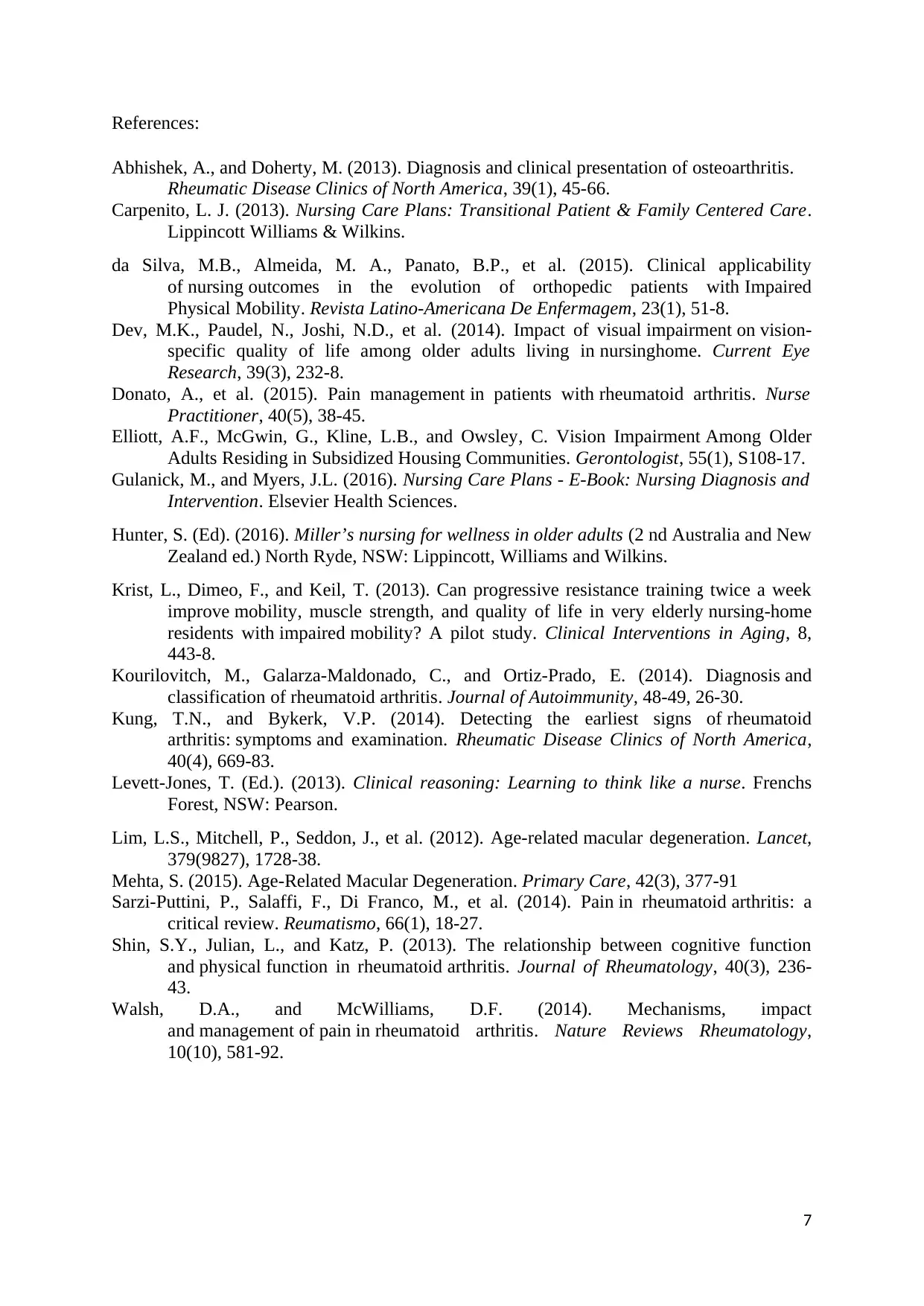
References:
Abhishek, A., and Doherty, M. (2013). Diagnosis and clinical presentation of osteoarthritis.
Rheumatic Disease Clinics of North America, 39(1), 45-66.
Carpenito, L. J. (2013). Nursing Care Plans: Transitional Patient & Family Centered Care.
Lippincott Williams & Wilkins.
da Silva, M.B., Almeida, M. A., Panato, B.P., et al. (2015). Clinical applicability
of nursing outcomes in the evolution of orthopedic patients with Impaired
Physical Mobility. Revista Latino-Americana De Enfermagem, 23(1), 51-8.
Dev, M.K., Paudel, N., Joshi, N.D., et al. (2014). Impact of visual impairment on vision-
specific quality of life among older adults living in nursinghome. Current Eye
Research, 39(3), 232-8.
Donato, A., et al. (2015). Pain management in patients with rheumatoid arthritis. Nurse
Practitioner, 40(5), 38-45.
Elliott, A.F., McGwin, G., Kline, L.B., and Owsley, C. Vision Impairment Among Older
Adults Residing in Subsidized Housing Communities. Gerontologist, 55(1), S108-17.
Gulanick, M., and Myers, J.L. (2016). Nursing Care Plans - E-Book: Nursing Diagnosis and
Intervention. Elsevier Health Sciences.
Hunter, S. (Ed). (2016). Miller’s nursing for wellness in older adults (2 nd Australia and New
Zealand ed.) North Ryde, NSW: Lippincott, Williams and Wilkins.
Krist, L., Dimeo, F., and Keil, T. (2013). Can progressive resistance training twice a week
improve mobility, muscle strength, and quality of life in very elderly nursing-home
residents with impaired mobility? A pilot study. Clinical Interventions in Aging, 8,
443-8.
Kourilovitch, M., Galarza-Maldonado, C., and Ortiz-Prado, E. (2014). Diagnosis and
classification of rheumatoid arthritis. Journal of Autoimmunity, 48-49, 26-30.
Kung, T.N., and Bykerk, V.P. (2014). Detecting the earliest signs of rheumatoid
arthritis: symptoms and examination. Rheumatic Disease Clinics of North America,
40(4), 669-83.
Levett-Jones, T. (Ed.). (2013). Clinical reasoning: Learning to think like a nurse. Frenchs
Forest, NSW: Pearson.
Lim, L.S., Mitchell, P., Seddon, J., et al. (2012). Age-related macular degeneration. Lancet,
379(9827), 1728-38.
Mehta, S. (2015). Age-Related Macular Degeneration. Primary Care, 42(3), 377-91
Sarzi-Puttini, P., Salaffi, F., Di Franco, M., et al. (2014). Pain in rheumatoid arthritis: a
critical review. Reumatismo, 66(1), 18-27.
Shin, S.Y., Julian, L., and Katz, P. (2013). The relationship between cognitive function
and physical function in rheumatoid arthritis. Journal of Rheumatology, 40(3), 236-
43.
Walsh, D.A., and McWilliams, D.F. (2014). Mechanisms, impact
and management of pain in rheumatoid arthritis. Nature Reviews Rheumatology,
10(10), 581-92.
7
Abhishek, A., and Doherty, M. (2013). Diagnosis and clinical presentation of osteoarthritis.
Rheumatic Disease Clinics of North America, 39(1), 45-66.
Carpenito, L. J. (2013). Nursing Care Plans: Transitional Patient & Family Centered Care.
Lippincott Williams & Wilkins.
da Silva, M.B., Almeida, M. A., Panato, B.P., et al. (2015). Clinical applicability
of nursing outcomes in the evolution of orthopedic patients with Impaired
Physical Mobility. Revista Latino-Americana De Enfermagem, 23(1), 51-8.
Dev, M.K., Paudel, N., Joshi, N.D., et al. (2014). Impact of visual impairment on vision-
specific quality of life among older adults living in nursinghome. Current Eye
Research, 39(3), 232-8.
Donato, A., et al. (2015). Pain management in patients with rheumatoid arthritis. Nurse
Practitioner, 40(5), 38-45.
Elliott, A.F., McGwin, G., Kline, L.B., and Owsley, C. Vision Impairment Among Older
Adults Residing in Subsidized Housing Communities. Gerontologist, 55(1), S108-17.
Gulanick, M., and Myers, J.L. (2016). Nursing Care Plans - E-Book: Nursing Diagnosis and
Intervention. Elsevier Health Sciences.
Hunter, S. (Ed). (2016). Miller’s nursing for wellness in older adults (2 nd Australia and New
Zealand ed.) North Ryde, NSW: Lippincott, Williams and Wilkins.
Krist, L., Dimeo, F., and Keil, T. (2013). Can progressive resistance training twice a week
improve mobility, muscle strength, and quality of life in very elderly nursing-home
residents with impaired mobility? A pilot study. Clinical Interventions in Aging, 8,
443-8.
Kourilovitch, M., Galarza-Maldonado, C., and Ortiz-Prado, E. (2014). Diagnosis and
classification of rheumatoid arthritis. Journal of Autoimmunity, 48-49, 26-30.
Kung, T.N., and Bykerk, V.P. (2014). Detecting the earliest signs of rheumatoid
arthritis: symptoms and examination. Rheumatic Disease Clinics of North America,
40(4), 669-83.
Levett-Jones, T. (Ed.). (2013). Clinical reasoning: Learning to think like a nurse. Frenchs
Forest, NSW: Pearson.
Lim, L.S., Mitchell, P., Seddon, J., et al. (2012). Age-related macular degeneration. Lancet,
379(9827), 1728-38.
Mehta, S. (2015). Age-Related Macular Degeneration. Primary Care, 42(3), 377-91
Sarzi-Puttini, P., Salaffi, F., Di Franco, M., et al. (2014). Pain in rheumatoid arthritis: a
critical review. Reumatismo, 66(1), 18-27.
Shin, S.Y., Julian, L., and Katz, P. (2013). The relationship between cognitive function
and physical function in rheumatoid arthritis. Journal of Rheumatology, 40(3), 236-
43.
Walsh, D.A., and McWilliams, D.F. (2014). Mechanisms, impact
and management of pain in rheumatoid arthritis. Nature Reviews Rheumatology,
10(10), 581-92.
7
1 out of 7
Related Documents
Your All-in-One AI-Powered Toolkit for Academic Success.
+13062052269
info@desklib.com
Available 24*7 on WhatsApp / Email
![[object Object]](/_next/static/media/star-bottom.7253800d.svg)
Unlock your academic potential
© 2024 | Zucol Services PVT LTD | All rights reserved.


